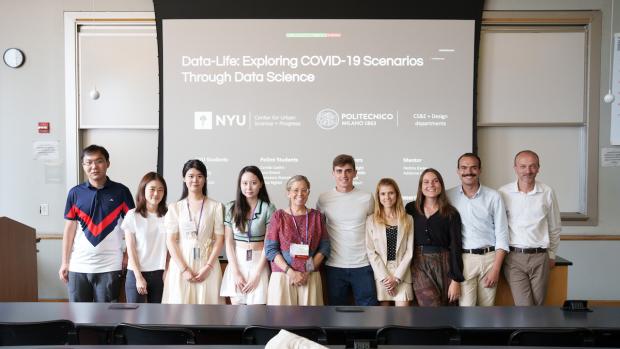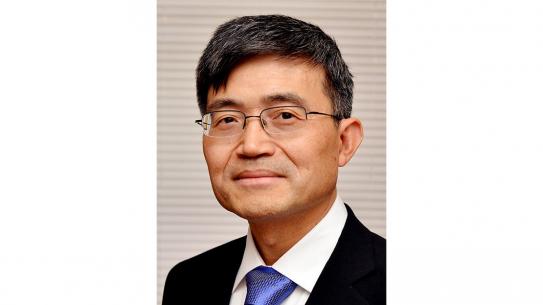Capstone projects from Tandon’s Center for Urban Science + Progress result in data-driven policy recommendations and real-world solutions

One of the many student teams that participated in CUSP's Capstone Program in which students seek data-driven solutions to complex urban challenges.
Each year, NYU Tandon’s Center for Urban Science + Progress (CUSP) invites government agencies, private-sector companies, non-profit organizations, think tanks, and academics from schools all over the world to submit project proposals and then collaborate with graduate-student teams on undertaking them.
It’s part of a Capstone Program aimed at providing master’s degree candidates with real-world experience in finding data-driven solutions to complex urban challenges, with the understanding that lessons learned in New York City — CUSP’s living laboratory — can be applied to improve areas everywhere.
In 2022, the Center received its highest-ever number of proposals, and those chosen for the program encompassed four major themes: disaster resilience and climate change, fairness and inclusivity, health and wellbeing, and modern civil and communications infrastructure.
By the summer, teams had tackled almost 40 projects, which they presented at a daylong conference in front of sponsors, CUSP alumni, and interested members of the public. You can read more about all of the CUSP 2022 Capstone Projects, but highlights included:
-
Emergency Response after Earthquakes: Assessing Risk and Guiding Coordination in Hospital Systems, a project jointly sponsored by Professor Luis Ceferino of Tandon’s Disaster Risk Analysis Lab, the World Bank’s Global Facility for Disaster Reduction and Recovery, and the Earthquake Engineering Research Institute’s Public Health Working Group, with the goal of informing practical risk mitigation policy implementation and emergency planning and helping communities mitigate not only potential economic losses but functional and societal impacts (Disaster Resilience and Climate Change)
-
Data-Life: Exploring Post-Covid Scenarios through Data Science, a project suggested by Politecnico di Milano professors interested in combining quantitative data from a wide variety of sources to gain an understanding of people’s perceptions of the present and future of the pandemic and how they might react to alternative policies and decisions (Disaster Resilience and Climate Change)
-
A Tale of Two Cities: Assessing the State of the Thermal Environment for New York and Athens, which sought to develop and apply a methodological approach for the recognition of thermal “hot spots” and “cold spots” in each city. Mitigation plans to counteract overheating in urban areas need to be based on a thorough knowledge of the state of the thermal environment–most importantly on the presence of areas that consistently demonstrate higher or lower urban land surface temperatures, a controlling factor of energy exchange between the surface and the atmosphere, and thus a cause of meteorological and climatic variation. (Disaster Resilience and Climate Change)
-
A New Dataset to Develop Smart Assistants for Specialized Training with Augmented Reality, inspired by the fact that emergency response personnel such as firefighters or utility workers require specialized training on time- and precision-sensitive tasks, and comprehensive training requires time, practice, and continuous guidance from a professional and experienced trainer able to predict and correct the trainee’s actions. Ideally, such training could be carried out by an automatic and smart agent using augmented reality devices like the Hololens, and the CUSP team aimed to develop an AR system to monitor the trainee’s actions as they learn those specialized tasks. (Disaster Resilience and Climate Change)
-
Repairing Dallas: Leveraging Data to Improve Housing Quality, an initiative suggested by the Texas-based Child Poverty Action Lab that called upon a CUSP team to collect granular data the city can use to direct aid where it is most needed (Fairness and Inclusivity)
-
Simulating Interactions with Visually Impaired, sponsored by NYU Tandon Professor Maurizio Porfiri, who explained that urban environments present particularly dire challenges for the visually impaired, who must travel complex routes in often crowded and noisy conditions with limited to no assistance; he charged the students with creating augmented and virtual reality technology that would allow visually impaired individuals to practice their orientation and mobility skills in a safe environment (Fairness and Inclusivity)
-
Challenges and Solutions for Walking with Assistive Wearable Robots in Urban Environments, sponsored by NYU Tandon Professor Joo H. Kim of the Applied Dynamics and Optimization Laboratory, who tasked the student team with identifying the challenges faced by those with lower-limb disabilities who use wearable robots such as powered exoskeletons and prosthetics in real-world urban environments (Health and Wellbeing)
-
Mapping Agricultural Production in NYC (M.A.P. NYC), whose aim was to identify gaps and opportunities in the local food landscape — analyzing links between urban agriculture and food security status, health outcomes, and land use — and report the findings to the new Office of Urban Agriculture (Health and Wellbeing)
-
The Electric Commute: Envisioning 100% Electrified Mobility in New York City (TEC-NYC), which sought to extrapolate NYC’s transportation needs to predict electric charging demand, including emerging mobility trends (such as electric scooters) and remote work patterns, thus allowing citizens, urban planners, and politicians to analyze the impact of mobility electrification and their policy decisions (Modern Civil and Communications Infrastructures)
-
RealCity3D: A Large-Scale Georeferenced 3D Shape Dataset of Real-world Cities, which leveraged rare city-level shape datasets with a high variance in geometric complexity and spatial layout styles, such as residential, historical, and commercial buildings and skyscrapers (Modern Civil and Communications Infrastructures)
The projects resulted in practical, actionable insight and provided students with the chance to serve real clients with real problems, just as they will upon entering the workforce with their master’s degrees.
Dr. Danielle Wright, CUSP’s Director of Academic Affairs, praised the students’ effort and expressed gratitude to the dozens of project sponsors who worked with them. “The capstones present a win-win situation for all,” she said. “The sponsors got the benefit of working with our enthusiastic, tech-savvy students, and, in turn, the students left their comfort zones to tackle problems in areas they might never before have considered, expanding their horizons and learning the value of data in every sector.”
Wright noted that in addition to city agencies and international organizations, there were several faculty members from Tandon and other schools among the sponsors. “Often, researchers are reluctant to share their data outside the lab,” she explained, “so to have so many of them willing to enlist our aid on their projects reflects very well on CUSP’s growing reputation and the caliber of the work being done here.”
Manager of Student Engagement and Academic Administration Peter Huu Tran, who helped plan the event, pointed out that it could be considered a celebration of sorts. “CUSP is marking its 10th anniversary, and it seemed fitting to inaugurate the capstone conference this year,” he said. “We anticipate that this will be an annual occurrence, and given how much CUSP is growing, next year’s event will be even more exciting.”




